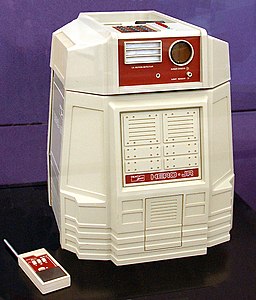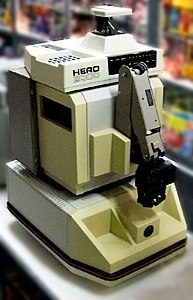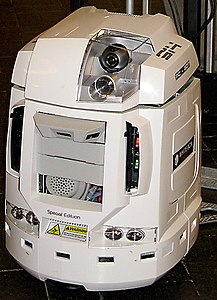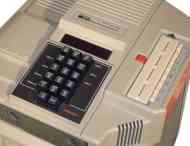HERO (robot)
| HERO 1 | |
|---|---|
 HERO 1 |
|
| Type | autonomous mobile robot |
| Manufacturer | Heathkit |
| publication | 1982 |
| Technical specifications | |
| Actuators | 3 wheels (1 controllable drive wheel) Robotic arm speech synthesizer 6 7-segment LEDs |
| Sensors | Ultrasonic audio |
| operating system | - |
| computer | Motorola 6808 |
| connections |
RS-232 |
| communication |
RS-232 |
| energy | 4 × 6 V gel batteries |
| measures and weight | |
| Dimensions (H × W × D) | 500 × 450 × 450 mm |
| Weight | 18,000 g |
HERO ( H eathkit E ducational RO bot ) is a series of robot kits produced by Heathkit during the 1980s. Development of the project began in October 1979 and the first devices were available in 1982. The last units were produced in 1990. The first kit - the HERO 1 - was followed by the HERO Jr. and the HERO 2000. While the HERO 1 and the HERO 2000 were used for teaching and training purposes, the HERO Jr. as a personal robot was intended to be more than an electronic toy.
HERO 1 (ET-18)
HERO 1 is a mobile robot that is controlled by an integrated microcomputer based on a Motorola 6808 CPU with 4 kB RAM .
construction
Under the gray plastic housing of the approximately fifty centimeter high device is a robust metal chassis that is mounted on two running wheels and a rotating drive wheel. The robot is supplied with energy by four large batteries and has a total weight of around fifteen kilograms. Various sensor and control boards are attached around the chassis, via which the sensors located in the rotating head are controlled. With its sensors, the HERO 1 is able to detect noises, movements and light sources and to measure distances using sonar . He can utter entire sentences using the optionally available speech synthesizer . A gripper arm movable in five axes, which was available as an extension kit, expands the possibilities of the robot model. The robot is programmed using a hexadecimal keyboard attached to the head and six 7-segment LEDs or an optional BASIC module. An interface for a cassette recorder enables the programs entered to be saved. There is also a patch panel on the head which can be used to set up experimental circuits.
Optional accessories
- Robot arm, movable around five axes with a load capacity of approx. 450 g
- Speech synthesizer
- two different remote controls
- ROM with demo software
- Monitor ROM listing
- Memory expansion card
- Auto Mode ROM, enables the robot to navigate independently
- BASIC module
- serial RS-232 interface
- Compact cassette with demo software
Trivia
During the first presentation in Germany, the HERO 1 sang Alle mein Entchen .
Technical specifications
| processor | Motorola 6808 |
| R.A.M. | 4 kB |
| Monitor ROM | 2 kB |
| input | Hexadecimal keyboard with 17 keys |
| output | 6 7-segment LEDs |
| Mass storage | Compact cassette |
HERO Jr. (RT-1)
| HERO Jr. | |
|---|---|
 HERO Jr. |
|
| Type | autonomous mobile robot |
| Manufacturer | Heathkit |
| publication | 1984 |
| Technical specifications | |
| Actuators | 3 wheels (1 steerable drive wheel) speech synthesizer |
| Sensors | Ultrasonic audio light infrared (optional) |
| operating system | - |
| computer | Motorola 6808 |
| connections |
RS-232 |
| communication |
Radio remote control |
| energy | 2 × 6 V gel batteries |
| measures and weight | |
| Dimensions (H × W × D) | 480 × × mm |
| Weight | 10,000 g |
HERO Jr. is a smaller version of the HERO 1 and was released later. The smaller brother of the HERO 1 is also based on a 6808 CPU, but has only 2 kB of RAM and a reduced range of functions. Unlike the other two HERO models developed by the Education Systems Department, the HERO Jr., as a Personal Robot, was a product of the Consumer Electronics Department.
Optional accessories
- Infrared motion detector
- Remote control
- serial RS-232 interface
- Additional batteries
- Plug-in module adapter for modules with 8 kB RAM
Technical specifications
| processor | Motorola 6808 |
| R.A.M. | 4 kB, expandable to 24 kB |
| Monitor ROM | 32 kB |
| input | Hexadecimal keyboard with 17 keys |
| output | 9 LEDs |
HERO 2000 (ET-19)
| HERO 2000 | |
|---|---|
 HERO 2000 |
|
| Type | autonomous mobile robot |
| Manufacturer | Heathkit |
| publication | 1986 |
| Technical specifications | |
| Actuators | Robotic arm |
| operating system | BASIC implementation |
| computer | Intel 8088 |
| connections |
electricity |
| communication |
Radio remote control |
| energy | 1 × 24 Ah battery |
| measures and weight | |
| Dimensions (H × W × D) | 810 ×? ×? mm |
| Weight | 35,000 g |
The HERO 2000, which appeared much later, is considerably better equipped. It has an Intel 8088 CPU and various sensors and can be expanded with plug-in cards. Unlike the HERO 1 and HERO Jr., the only aid can be programmed assembly language, the HERO 2000 has a complete BASIC - implementation .
Optional accessories
- Robot carrying case
- two different remote controls
- Auto-Dock (automatically guides the system to the charging station when the batteries are low)
- ROM with demo software
- Experimental plug-in card with buffered input / output
- Memory expansion card
- 360 kB floppy disk drive with controller
Technical specifications
| processor | Intel 8088 |
| R.A.M. | 24 kB, expandable to 576 kB |
| Monitor ROM | 64 kB with built-in BASIC |
| input | Terminal via RS-232 interface |
| output | Terminal via RS-232 interface |
HE-RObot
| HE-RObot | |
|---|---|
 HE-RObot |
|
| Type | autonomous mobile robot |
| Manufacturer | Heathkit |
| publication | 2007 |
| Technical specifications | |
| Actuators | LED headlights DC stepper motors |
| Sensors | Webcam infrared |
| operating system | Windows XP |
| computer | Intel Core Duo |
| connections |
USB |
| communication | |
| energy | 2 × 12 V, 9 Ah lead battery |
| measures and weight | |
| Dimensions (H × W × D) | 530 × × mm |
| Weight | 25,000 g |
In December 2007, Heathkit re-introduced a robot model for educational purposes after more than a decade. Identical devices are also offered by other companies (e.g. White Box Robotics and cogmation Robotics) under the name 914 PC-BOT .
hardware
The device is based on an industrial PC with an Intel Core Duo processor on a Mini-ITX motherboard and an 80 GB hard disk. The peripherals built into the device consist of a webcam , a CD-ROM / CD-RW combo drive , a USB host, LED headlights, eight infrared sensors, speakers and a WLAN chipset. Sensors and other circuits can be controlled via an I / O board with eight analog inputs, eight digital inputs and eight digital outputs. A second I / O board can be installed as an option. The chassis, which makes the robot mobile, is driven by DC stepper motors that are fed by two 12 volt lead-acid batteries .
software
The HE-RObot can be programmed in any language supported by .NET using the supplied Microsoft Visual Studio 2005 . Here are algorithms for speech recognition , navigation and artificial intelligence supported.
Technical specifications
| processor | Intel Core 2 Duo with 2 GHz |
| R.A.M. | 1 GB DDR2 |
| Mass storage | 80 GB hard drive, DVD-ROM / CD-RW combo drive |
| height | about 53 cm |
| Weight | about 25 kg |
literature
- Mark J. Robillard: HERO 1 - Advanced Programming and Interfacing, HW Sams 1983, ISBN 0672221659
- Howard Boyet: Hero 1 - Advanced Programming Experiments, Heathkit / Zenith 1984, ISBN 0871190362
- John D. Hubbard, Lawrence P. Larsen: Hero 2000 - Programming and Interfacing, Heathkit / Zenith 1986, ISBN 0871191539
